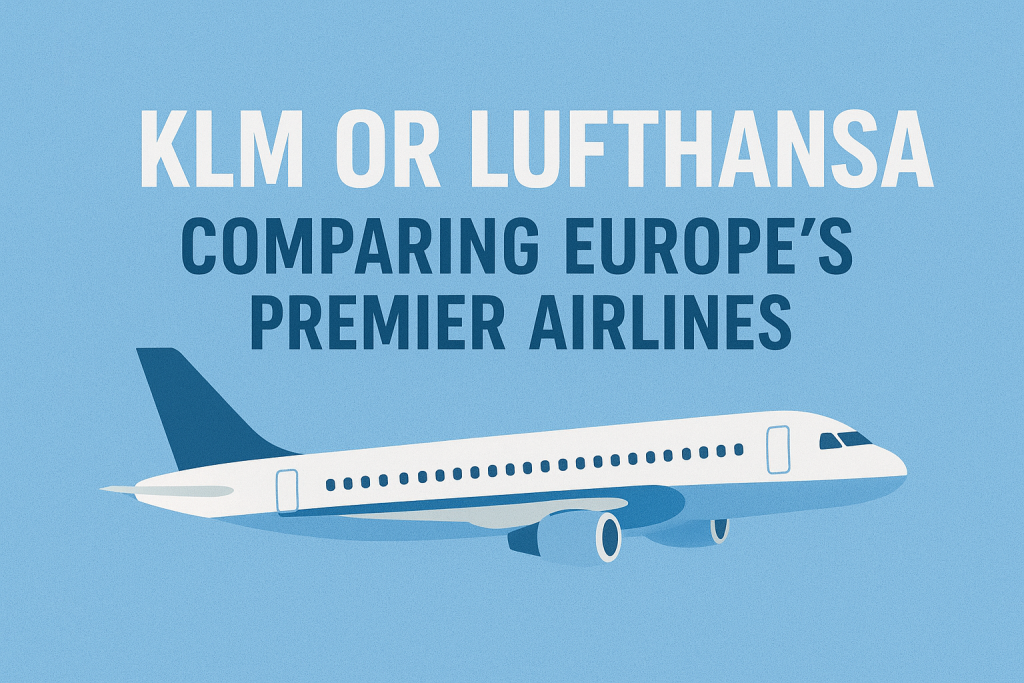It can be tough for travelers to know which one to go with when it comes to dependable European airlines. Each has proven itself as a professional leader, but they are very different in the way they operate and the experience they deliver, along with very different route networks and levels of service. This detailed comparison of the main aspects will highlight the most significant differences and enable you to make a better decision between KLM vs Lufthansa.
Company Profile and Fleet
Established in 1919, KLM Royal Dutch Airlines is the oldest airline in the world still operating under its original name. KLM is a full-service carrier with a modern fleet of about 110 aircraft based in Amsterdam Schiphol, including mostly Boeing 737, 777, 787 Dreamliner (executive and Economy on long haul), and some older models of the 747.
Lufthansa was founded in 1953 and has its main hubs at Frankfurt and Munich. Lufthansa is the largest airline group in Europe and operates a fleet of more than 250 aircraft, including the Airbus A320 family for its short-haul services and the A350 and Boeing 747-8 for its long-haul operations.
Route Network and Connectivity
Lufthansa, one of the best-connected airlines in the world, with over 200 destinations in more than 70 countries. The/fc dual hub in Frankfurt and Munich also enables us to offer our passengers a wide variety of connections to and from Europe, Asia, Africa, and the Americas.
KLM flies to around 145 destinations worldwide, and as a single hub carrier, its Amsterdam Schiphol hub is very efficient. The airport’s layout is tight, allowing for quick connections, as little as 40 to 50 minutes between flights. Both are SkyTeam and Star Alliance members, respectively, and they also extend their global network through codeshare agreements.

Experience the cabin and comfort.
Inside the cabin, KLM features its familiar blue and orange color palette. Economy class has a standard seat pitch of 30-31 inches, and business class has lie-flat seats on long-haul services. The airline’s generous free onboard services include earphones and amenity kits on intercontinental flights.
About the cabins, Economy class offers similar legroom, whereas Premium Economy provides more space, wider seats, and more reclination. Business Class on Lufthansa also offers fully flat beds for most long-haul aircraft at the time of writing, with direct aisle access: a huge improvement on the cramped 2-2-2 seating layout that its competitors like British Airways still try to impose. First Class (on a few routes) impresses with private suites that have closing doors.
Service Quality and Hospitality
KLM is proudly Dutch, and so Dutch hospitality shines through in a relaxed and friendly customer service ethos. Flight Attendants are friendly and multilingual. The carrier applies the same service standards throughout the network, focusing on the passengers’ comfort and satisfaction.
Lufthansa offers professional and efficient service with German precision. The airline provides months of training for its crew, so you can expect high standards of safety and customer care. Service might be more formal than on KLM, but polite and attentive, all the easier for that reason.
Food and Beverage
Food and beverages are chargeable. Complementary meals and drinks are provided on long-haul flights; short-haul service has regional variations. Both airlines provide free meals and drinks on long-haul flights, but vary in their short-haul service. KLM offers Dutch cuisine with international influences, and cheese and stroop wafels are its signature products. Taste of Europe Lufthansa’s European cuisine highlights German specialties, bakery products such as a variety of quality breads, and premium beverages.
Frequent Flyer Programs
KLM’s Flying Blue loyalty scheme enables you to collect miles on KLM, Air France, and SkyTeam partner flights. It has four tier levels and gives you four ways to redeem your miles: upgrades, award flights, and experiences.
The Miles & More scheme of Lufthansa is one of the biggest loyalty programs in Europe. Members of the program earn miles and redeem miles on flights operated by Star Alliance carriers, as well as other benefits such as access to airline lounges, priority boarding, and extra miles for high-tier status holders.
Cost and value for money
The price depends greatly on the itinerary, season, and class of booking chosen. Both airlines are part of the same generally premium carrier category with similar rates. LH has more fare choices on account of the size of its network, and KL, on the other hand, can be the best value on certain routes via Amsterdam.
Summary
Both KLM and Lufthansa offer excellent European flight experiences, but with different flavors. KLM provides the best connections via Amsterdam with friendly, informal service, and Lufthansa has a huge network and German efficiency. It comes down to the convenience of routing, personal preference, and whether you are a member of either airline’s frequent flyer program.
